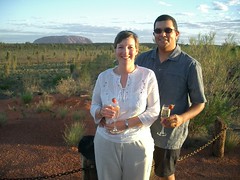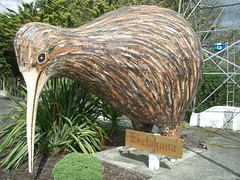Monday, February 27, 2006
Darwin
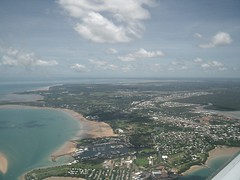 ....from the very hot to the very humid, we arrived in the capital of the Northern Territory and we saw far more green trees, lush grassland and lots of stuff that looked alive rather than dead than we had seen for a while! Most of us grew up being taught that there are four seasons, the aboriginal people actually recognise six seasons (which does make some sense when you see it written down), however to the local people of European descent there are only two seasons up here..... "The Dry" and "The Wet". And we didn't arrive in The Dry!
....from the very hot to the very humid, we arrived in the capital of the Northern Territory and we saw far more green trees, lush grassland and lots of stuff that looked alive rather than dead than we had seen for a while! Most of us grew up being taught that there are four seasons, the aboriginal people actually recognise six seasons (which does make some sense when you see it written down), however to the local people of European descent there are only two seasons up here..... "The Dry" and "The Wet". And we didn't arrive in The Dry!Darwin is probably best described as the Australian equivalent of Milton Keynes (although we have yet to visit Canberra). Those buildings that weren't bombed by the Japanese in 1942 were destroyed by Cyclone Tracy in 1974 so it is basically a 'new town'. It is a wonderful mixture of 70's architecture, complete with those cement floral brick things that people used to build garden walls out of and then paint white! It is also good as it is quite compact and with the humidity as it is, walking about wasn't a pleasant experience. Cyclone Tracy seems to have given Darwinians the opportunity to build plenty of pavement cafes in the guise of 'cappucino strip' (all towns seem to have one!), a new waterside Esplanade which gives great views out to the sea and brand spanking new backpackers accomodations (relatively speaking!) complete with swimming pools and air conditioning!
One of the major toursit attractions is unsurprisingly focused around the water (as most of Australia is) and is called Aquascene. At high tide hundreds of fish come into the shore to be fed huge amounts of bread, the supply seems to be limitless as do their apetites! Rules are : grab some bread, the mouldier the better and put your hand in the water and soon hundreds of fish are surrounding you and literally eating out of your hand! There are several types, including quite large Milk Fish all whom thankfully are not meat eaters and have no teeth so we were safe! There were are few rays (pictures are a bit poor of these compared to our previous efforts - sorry!), some cat fish and the Aussie icon the Barramundi! All in all we had a great time and made some great temporary friends who by next high tide will have forgotten we ever existed!
Darwin Pictures here.
Sunday, February 26, 2006
Alice Springs.....
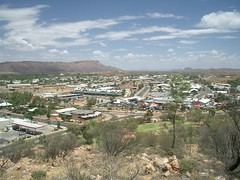 ..... usually referred to here as just "Alice", or sometimes even "The Alice". We stopped here partly because the flights were cheaper, but also because it's about the only other place to go in the centre of Australia! We'd always assumed that Alice Springs was quite close to Uluru, but the scale of Australian geography strikes yet again and it is actually a five and a half hour coach trip through nothing but stations. Not train stations but farms, averaging about 800,000 hectares each. How the devil you find your cattle on that amount of land is beyond me. As it is desert lands and not exactly the lush nourishment capital of the world, we wondered what the cattle actually eat .... in a word....anything!
..... usually referred to here as just "Alice", or sometimes even "The Alice". We stopped here partly because the flights were cheaper, but also because it's about the only other place to go in the centre of Australia! We'd always assumed that Alice Springs was quite close to Uluru, but the scale of Australian geography strikes yet again and it is actually a five and a half hour coach trip through nothing but stations. Not train stations but farms, averaging about 800,000 hectares each. How the devil you find your cattle on that amount of land is beyond me. As it is desert lands and not exactly the lush nourishment capital of the world, we wondered what the cattle actually eat .... in a word....anything!We managed to pick a hotel right out on the edge of town which, although convenient for the casino!, meant that we had to get into town by taxi as the buses don't appear to run Sundays! Whilst it would have been possible to walk it, we didn't have a map and didn't really know how far we actually were out of the town centre and it was 40 degrees outside which isn't conducive to walking anywhere and consequently would have taken us all day and we only had one day here. We had 3 main objectives in this ridiculous heat, 1, climb Anzac hill (remembering it is 40 degrees outside), 2, visit School of the Air and 3, visit the Royal Flying Doctors Service. The hill wasn't as bad as it sounds as it is rather more a small mound rather than Ben Nevis but it did give us some good views of "The Alice" and this little spot of life in amongst millions of acres of bush. The tourist information centre also advised us that on weekends the School of the Air is pre recorded so there isn't really anything to see and there is no teacher for the tuned in students to interact with. This was a shame as it would have been really interesting to see how it all works and listen in on a class.
So we did a brief walking tour of the town centre and then headed for objective 3, the Royal Flying Doctor Service visitor centre........
The hub of the RFDS in Alice was also not operational on a Sunday as it is covered by another centre but they are still open for guided tours. After a brief video about the history and stuff, we headed to the main control room which is not much bigger than a single garage but is the lifeline for the people that live in an area larger than the UK. About 80% of Australia is covered by the RFDS and centres like the one in Alice and given the scale of this massive country, it is a big job. It is beyond words the incredible job that they do and left us all speechless after we had walked round and seen the museum. Whilst the Government do provide some money to the service, much of its ongoing survival is possible as a result of donations and fund raising. It was a real "...I want to leave all my money to the cats home..." moment but as we don't have that much spare, we added our bit of support by purchasing a few things from the 'very reasonably priced' gift shop. Had it not been for the constraints of our back packs, we may have ended up with much more but we definitely did our bit and felt the better for it.
All in all "The Alice" seems to be a bustling town full of really friendly people who seem to be extremely proud of where they live, the bus driver we had oozed passion for the town and the taxi driver was very keen to tell us the finer qualities of ALL the Aussie beers so that we have a list as long as your arm of what to try next.
Thursday, February 23, 2006
The Sounds of Silence
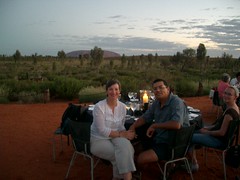 No, not a Simon & Garfunkel tribute band, but the top 'Dining Experience' at the Ayers Rock Resort. You get dropped off at the edge of the resort and, after watching the sun set over Uluru, you have dinner 'under the stars'. If you've seen enough local wildlife and you now fancy eating some of it, this is the place to come, the food is very good but based on what we had I think vegetarians might find the choice a little limited. Crocodile Ceasar Salad was very good but we weren't so keen on medium rare Kangaroo steak.
No, not a Simon & Garfunkel tribute band, but the top 'Dining Experience' at the Ayers Rock Resort. You get dropped off at the edge of the resort and, after watching the sun set over Uluru, you have dinner 'under the stars'. If you've seen enough local wildlife and you now fancy eating some of it, this is the place to come, the food is very good but based on what we had I think vegetarians might find the choice a little limited. Crocodile Ceasar Salad was very good but we weren't so keen on medium rare Kangaroo steak.After dinner (and the didgeridoo player) all the lights and candles were put out so we could see the stars properly. It is of course extremely dark in the desert at night, with no light polluting cities for hundreds of miles, so we definitely saw more stars than we have ever seen before. The local astronomer was on hand to give a brief explanation of what we could see, and there were also some telescopes set up which was quite good fun (although you do have to be careful not to fall over as you wander around in the dark).
Wednesday, February 22, 2006
Uluru-Kata Tjuta National Park
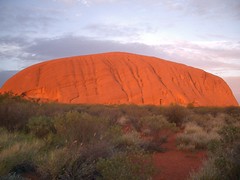 It's taken us two visits to Australia but we've finally made it to the middle, and one of the most recognisable natural landmarks in the world. Or, to put it another way, we've got on another plane and flown for two hours into the middle of nowhere to see yet another old rock. Quite an impressive rock though. The fact that it really is in the middle of nowhere seems to add to the effect, although it also makes it difficult to judge the size from a distance because there are so few reference points. The approach to the runway seemed to involve a big turn that meant both sides of the plane got a good look and a chance for some photos, don't know whether it was really for the benefit of the tourists or not!
It's taken us two visits to Australia but we've finally made it to the middle, and one of the most recognisable natural landmarks in the world. Or, to put it another way, we've got on another plane and flown for two hours into the middle of nowhere to see yet another old rock. Quite an impressive rock though. The fact that it really is in the middle of nowhere seems to add to the effect, although it also makes it difficult to judge the size from a distance because there are so few reference points. The approach to the runway seemed to involve a big turn that meant both sides of the plane got a good look and a chance for some photos, don't know whether it was really for the benefit of the tourists or not!The airport shuttle is free, but then it doesn't take you that far and there is only one resort that you can stay at anyway! There is though a wide range of accommodation, starting with a campsite and working up. After many weeks of consideration we had finally, and with some disappointment, settled for a 'cabin' in the campsite (the tents are cheaper, but this is not the season to be without air-conditioning!). We had tried to persuade ourselves that we could afford to treat ourselves to a stay at Longitude 131 (well, Nikky had insisted that my redundancy would cover it), but we eventually decided that £1,500 for two nights was not really in line with our budget! Maybe next time.
The resort is about 15km from the rock and most people seem to get there either on a coach tour or on the (not free) shuttle bus. Neither of these are particularly cheap, and considering the limited amount of time we've seen coach tours stop at most places we decided to hire a car for a day (bike hire is available for the insane!). The first stop inside the National Park is the Aboriginal Cultural centre. Most of the coach tours seem to stop for about 30 minutes here, but this isn't really anywhere near long enough as we spent well over an hour inside and didn't read everything or watch all the videos.
As you get closer to the rock you realise that it isn't quite such a simple shape as it seems in all the photos you've seen. It always looks very rectangular to me, but in some of the aerial shots it actually looks almost triangular. Most photos you see are also taken from quite a distance to get it all in so we didn't expect the surface to be as interesting as it is. There are small areas of unusual shapes and it's covered in potholes, cracks and different coloured marks. Many of these features are central to the 'Dreaming' stories of the local people which explain how Uluru was created.
Having done a 'lap' of Uluru and taken more pictures than any sane person could possibly want of the same rock we headed off to Kata Tjuta about 50km away. Named by the Europeans as The Olgas, the individual rocks are smaller but they cover a larger area than Uluru. We did a short walk here but were unable to go any further as some areas are closed off when the temperature is above 36 degrees (not that we were planning to do too much strenuous walking in that heat anyway). Climbing Uluru is also off limits when the temperatures reach that level, although you are kindly asked to respect the wishes of the locals and not climb it anyway. (It's a sacred site, so the 'No Climb' request is really quite reasonable when you consider how offended many people would be if thousands of tourists decided to clamber up the outside of churches and mosques just so they could buy a t-shirt celebrating their efforts).
After Kata Tjuta we headed back to Uluru to join the dozens of people parked up to take photos of the rock at sunset. We're here at a relatively quiet time of year, so it must be chaos in the peak season. Some people have got proper tripods, others have rigged up elaborate constructions involving coolboxes and chairs, and others (like us) are just attempting to balance cameras on the roof of a car. Whichever method has been chosen we are all sitting there, very carefully lining up our cameras in order that we can all take dozens of almost identical pictures as the sun sets (we'd been given a tip to take a picture every 5 minutes). We didn't have the best sunset because of some low cloud, but it still kept most people snapping away until it was almost completely dark.
After sunset it was back to 'camp' for an early night, before getting up at 5am to drive all the way back for sunrise. Sunrise was even more crowded than sunset, cars and coaches just lined up at the side of the road, everyone trying to pick the perfect parking spot where they can stick the camera on the roof of the car and not have a tree obscuring their photos! This time I think we took even more photos, and also got a few more good 'Random Tourists' pictures. Proving the rule that, however early you arrive and however good the position you pick, someone will always turn up late and stand right in front of you. In this case they even took it a stage further and decided that, since it was a bit tiring to stand, they would just lean back and rest on our hire car!!! And then, as soon as the sun finaly clears the horizon everyone is back in their cars and headed back to the resort for breakfast, or in our case to check out and catch the bus to Alice Springs.
We've tried not to publish too many of the photos, so there is a set of general Uluru pictures, but there are also separate sets for sunset and sunrise if you really want to have a look. (There are even more taken with the 'Sunset' filter setting on one of our cameras for the truly dedicated, or if you are really bored at work!).
Tuesday, February 21, 2006
Pinnacles
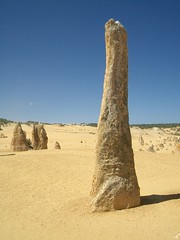 On our last day before arriving back in Perth we stopped at the Nambung National Park, home to the Pinnacles (yes, more old rocks!). Coincidentally, the night before we came here we had seen Billy Connolly interviewed on Australian TV and they showed a clip from his tour of Australia series where he had visited the Pinnacles and appeared to have danced naked amongst them. He went on to explain that he has since received photos and videos from fans who have come here and done exactly the same thing. You will probably all be pleased to know that we did not carry on the tradition! They do make quite a fascinating sight though, and we may well have stayed a little longer if it wasn't for the extreme heat and what appeared to be several million flies.
On our last day before arriving back in Perth we stopped at the Nambung National Park, home to the Pinnacles (yes, more old rocks!). Coincidentally, the night before we came here we had seen Billy Connolly interviewed on Australian TV and they showed a clip from his tour of Australia series where he had visited the Pinnacles and appeared to have danced naked amongst them. He went on to explain that he has since received photos and videos from fans who have come here and done exactly the same thing. You will probably all be pleased to know that we did not carry on the tradition! They do make quite a fascinating sight though, and we may well have stayed a little longer if it wasn't for the extreme heat and what appeared to be several million flies.More photos here.
Saturday, February 18, 2006
Monkey Mia
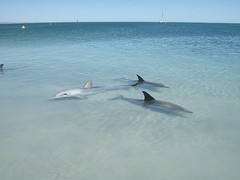 Further south than Exmouth but almost as far from the main road is the town of Denham. A few Kms further up the road is Monkey Mia, which is really nothing more than a holiday camp (although it caters for everyone from campers and backpackers to more expensive 'villas'). There are in fact no monkeys here, there is only one reason why most people are here and that is to see dolphins.
Further south than Exmouth but almost as far from the main road is the town of Denham. A few Kms further up the road is Monkey Mia, which is really nothing more than a holiday camp (although it caters for everyone from campers and backpackers to more expensive 'villas'). There are in fact no monkeys here, there is only one reason why most people are here and that is to see dolphins.The story is similar to Bunbury, some years ago somebody managed to hand feed some dolphins on the beach and they have been coming back ever since. We only spent two mornings at Bunbury, so it may not be a fair comparison, but we saw a lot more dolphins here and the beach, weather and water temperature were much better. Once again they really did come right up to within a few feet of the beach, and the water was also much clearer which helped the photography. Feeding takes place three times during the morning (depending on when the dolphins turn up). They also feed the local pelicans who would otherwise try and steal from the dolphins, in fact the pelicans seem to have an easy life because after they've been fed they stand around the lawns 'drinking' water from the sprinklers.
In the afternoons the dolphins also tend to return and swim around not far from the beach, amongst all the people and the small boats tied up offshore. It's probably one of very few places in Australia where there isn't a stampede for the shore when fins are spotted in the water!
We didn't go on any of the boat tours here, but if you're here you can take trip out to try and see the local Dugongs. Apparently about 10% of the worlds population live in the surrounding Shark Bay (they feed on the large amounts of sea grasses which are the reason for the bay having World Heritage status).
There's one more thing to see around here, just back near the junction with the main highway. Stromatolites. Huh?! The Stromatolites were only discovered here in the 1950's and apparently there are only two or three places in the world where they are known to exist (although this is claimed to be the most accessible site).
There's really no way of making this sound any more exciting, but basically we stopped to look at some old rocks........... but these aren't just any old rocks, they're 'living' rocks and they are 3.5 billion years old. Well, the actual rocks we saw may not be that old but they have existed in the same form for all that time. You may not be surprised to hear that they aren't all that exciting to look at! So unless you are really into the science then it probably isn't worth making the 850 mile round trip from Perth just to see them, but if you're passing anyway then it's worth stopping. Check out the photos to see just how exciting they really are.....
The dolphin photos are here.
Wednesday, February 15, 2006
Ningaloo Reef Marine Reserve
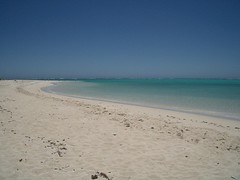 We weren't originally going to come all the way up here, but after hearing and reading more about it (and after discovering how cold the water was down south!) we decided to fit it in. It isn't anywhere near as big as the Great Barrier Reef, but it's very close to the shore and thanks to its remoteness it has comparatively few visitors.
We weren't originally going to come all the way up here, but after hearing and reading more about it (and after discovering how cold the water was down south!) we decided to fit it in. It isn't anywhere near as big as the Great Barrier Reef, but it's very close to the shore and thanks to its remoteness it has comparatively few visitors.Even after you've finally reached the town of Exmouth you still have to drive another 65km around the headland to reach the main snorkelling areas. This does however mean that it is all very unspoiled, no gift shops, cafes etc. In fact the only things you will see are a few picnic tables and the odd toilet, and even those don't exist at all the sites.
I'm not sure that it was the best snorkelling we've done, but there are a lot of fish, rays and clams and stuff. There are so many places to snorkel that you really need to spend longer than a couple of days here to make the most of it, there are of course also plenty of dive shops who will take you out for a fee (quite a large fee around here it seemed!). Once again the method of putting the camera in a waterproof bag that was not designed for photography proved to be rather ineffective, but the pictures are here if you want to see just how bad they are (no, really you can actually see fish in them!).
Highlight of the day was spotting a turtle off one of the beaches. We were a few weeks late for the hatching season so we hadn't expected to see any at all and certainly not in the middle of the afternoon. Unfortunately by the time we got in the water it had disappeared, no doubt scared off by our less than graceful snorkelling style! Whale sharks are the other big attraction around here and are apparently pretty harmless, but we weren't fortunate enough to see any. Although to be honest, if we'd seen one while we were in the water I'm not sure whether we'd have remained calm enough to enjoy it.......
"Ooh look, it's a whale shark...... aarrggh... SHARK!!!"
Tuesday, February 14, 2006
More Driving...
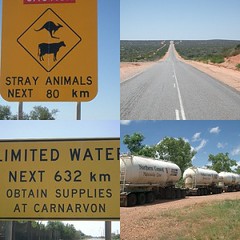 In England you usually just think of 'Roads', you don't normally have to worry about whether or not they have a tarmac surface. But it's different here, and when you're planning a trip you need to consider what the 'road' is actually going to look like! There are of course sealed roads linking most major towns, but to get to the more remote communities you are likely to find that you need to travel 150km along what looks like a dirt track (we didn't!).
In England you usually just think of 'Roads', you don't normally have to worry about whether or not they have a tarmac surface. But it's different here, and when you're planning a trip you need to consider what the 'road' is actually going to look like! There are of course sealed roads linking most major towns, but to get to the more remote communities you are likely to find that you need to travel 150km along what looks like a dirt track (we didn't!).One advantage of the more remote minor roads (and major roads in the Northern Territory) is that when you get away from the towns there is (so we have been assured) no speed limit. One reason for this is the road trains, big trucks with up to 4 trailers that can be 120ft long. If you get stuck behind one of these you want to be going quickly when you overtake or you'll be on the wrong side of the road for a long time.
Unlimited speed is not all good though, there are places where the tarmac section of the road is suddenly only wide enough for one car. There's still room for two cars of course, it's just that the outer edge of each lane is effectively a dirt road. So when you meet oncoming traffic you just have to take to drive off the edge of the tarmac and hope for the best!
There is also the danger of (literally) running into kangaroos, emus etc. in the middle of the road at any time. This did mean that at last we saw a real live kangaroo in the wild, and we didn't hit it either!
A Little Drive In The Country
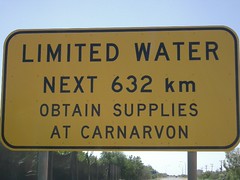 We were now leaving the south of Western Australia and heading for the town of Exmouth, about halfway up the west coast. This is of course a long way, but there must be something along the way, right? Not really. W.A. has a population of something like 2 million, but most of these people live in and around Perth, and most of the remainder live on the coast. So travelling anywhere away from the coast and away from Perth means a distinct lack of people, and in fact a distinct lack of much of anything!
We were now leaving the south of Western Australia and heading for the town of Exmouth, about halfway up the west coast. This is of course a long way, but there must be something along the way, right? Not really. W.A. has a population of something like 2 million, but most of these people live in and around Perth, and most of the remainder live on the coast. So travelling anywhere away from the coast and away from Perth means a distinct lack of people, and in fact a distinct lack of much of anything!Exmouth is nearly 1300km north of Perth, and besides the city of Geraldton (pop. 19,000) and the smaller town of Carnarvon there isn't much in between. Imagine doing the Lands End to John O'Groats run and only encountering one small town somewhere around Birmingham and another just before the Scottish border.
In fact, when you look at the map it seems that when you are nearly at Exmouth you take a turn off the main highway and follow the road to the end. What looks like a little side road is in fact 230km with nothing to look at but a few termite mounds along the side of the road. The only break in the scenery is the signpost as you cross the Tropic of Capricorn.
Monday, February 13, 2006
Wave Rock
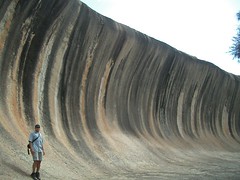 Having 'marvelled' at Dog Rock you'd have to wonder why we then decided to drive 350km to see Wave Rock. No prizes for guessing what it looks like..... Everything around here is so far apart that after a while a few hundred kilometres seems quite a reasonable distance to go to see a rock! Fortunately it is actually quite impressive once you get there.
Having 'marvelled' at Dog Rock you'd have to wonder why we then decided to drive 350km to see Wave Rock. No prizes for guessing what it looks like..... Everything around here is so far apart that after a while a few hundred kilometres seems quite a reasonable distance to go to see a rock! Fortunately it is actually quite impressive once you get there.We were going to stay locally but as we'd made good time we decided to start our journey north. So for the first time in our trip so far we headed off down the road with no idea where we were going to spend the night. One candidate was the town of Corrigin, it didn't turn out to be our stop for the night but it did boast a couple of tourist 'attractions'.
The first is the dog cemetery, another unambiguously named place. Some years ago a local man buried his dog here and then, for reasons which are not entirely clear, everyone wanted a go. So now there are dozens of them (apparently people travel from miles around now).
The second attraction is actually an event, but it continues the canine theme. Corrigin is home to 'Dog in a Ute', for which we were unfortunately a few weeks early. For the uninitiated a Ute (being short for 'utility vehicle' I think) is basically the Aussie version of the pickup truck, although many of them actually seem to be based on the Ford Sierra.
Anyhow, Dog in a Ute essentially involves trying to break the previous record for the largest convoy of, er, dogs in utes. Why this is necessary is once again unclear, but its future as an event seems safe as there appears to be a fierce rivalry between Corrigin and some town in Victoria that does the same thing. The current record (held by with immense pride by Corrigin) is just over 1500. Yes, that's right, one thousand five hundred pooch carrying pickups in a row. The assembly area is several kilometres away and apparently when the first trucks reached town the last ones had yet to leave the field. If anyone wants to know more (or enter) I'm sure the website has full details!
Saturday, February 11, 2006
Albany
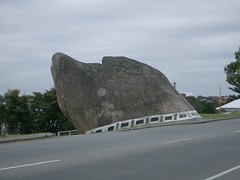 We had originally thought that we might get some snorkelling done around Albany, but we're discovering that the Southern Ocean is just too cold for our tastes! But before heading north for warmer waters we had a look to see what Albany has to offer tourists......
We had originally thought that we might get some snorkelling done around Albany, but we're discovering that the Southern Ocean is just too cold for our tastes! But before heading north for warmer waters we had a look to see what Albany has to offer tourists......The people who run the local YHA are very friendly and gave us loads of information and marked it all on a map for us (in colour-coded highlighter pens!). Since we had now only allowed ourselves a day we tried to see as much as we could, but there was plenty more. Everyone in the tourist information places around here is so enthusiastic that they seem quite genuinely disappointed if you are only going to be in town for a day!
The town seems very proud of Dog Rock. It's a rock.... that looks like a dog. Well, actually it looks like a dog's head. That is if you look at the right angle and notice the collar they've painted on to help you!
There are also quite a lot of nice looking beaches around here. However, due to the combination of cool weather, clouds and windy conditions (there's a wind farm nearby) we just looked on from a safe distance until the weather improved and we found some nice white sand!
We didn't have time to go into Whale World on the edge of town. This is an old whale 'processing' site, and apparently has lots of info about whale conservation these days, but from what we read on the board outside it looked more like a tour around all the places where they used to cut the whales up. Nice!
Friday, February 10, 2006
The Southern Forests
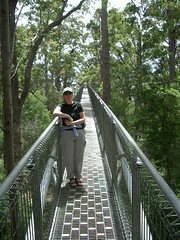 We're heading east across the bottom of the country now. Amongst other things it's apple growing country around here but there are also an awful lot of trees. There are 2 or 3 places where you can climb the trees that are used as fire lookouts, although we only climbed one! On the day we visited there was a controlled fire being carried out in the area, so it was lucky that we met one of the wardens who explained this to us before we drove through the area because at times it didn't look all that 'controlled'.
We're heading east across the bottom of the country now. Amongst other things it's apple growing country around here but there are also an awful lot of trees. There are 2 or 3 places where you can climb the trees that are used as fire lookouts, although we only climbed one! On the day we visited there was a controlled fire being carried out in the area, so it was lucky that we met one of the wardens who explained this to us before we drove through the area because at times it didn't look all that 'controlled'.We took a bit of a detour to follow up on another tip from someone we met in a hostel. This time we were looking for the village of Donnelly River, where we were told that the local shopkeeper feeds much of the local wildlife in the morning and evenings. When we arrived (in the middle of the day) we weren't really sure whether we had found the right place as it seemed to be almost deserted. We were just about to give up when we spotted an emu wandering around someone's garden, the only sign of life in the village so far. After eating our lunch on the local picnic bench nothing else had appeared so we decided to drive to the other end of the main 'street', turn around, and then head on to our next stop. Fortunately we chose the right direction and found numerous Kangeroos and Emus just resting in the shade at the end of the road. We were able to get quite close to them, and most of them just viewed us with suspicion and continued to lie in the shade, but one or two of the younger Kangaroos still found tourists a bit of a novelty (although they soon lost interest when it was clear that we weren't going to offer any food!).
We were climbing trees again at the "Tree Top Walk" , which basically involves a series of walkways that take you 40m up into the trees. This gives some pretty good views, and on the day we were there also quite an entertaining 'ride' as it sways about a bit in the breeze!
Thursday, February 09, 2006
Stingrays
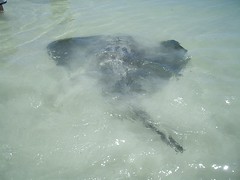 One thing we’ve noticed about this side of the country is that some of the tourist leaflets leave a little to be desired. If you’re driving from town A to town B they’ll tell you all about the accommodations and restaurants in both, but very little about anything you might want to see along the way. So you set off on a journey through apparent wilderness only to see a load of signposts for tourist attractions along the way. Our 2004 Fodor’s guide isn’t much better, and judging by the number of towns mentioned it seems that they didn’t actually spend much time in the state at all!
One thing we’ve noticed about this side of the country is that some of the tourist leaflets leave a little to be desired. If you’re driving from town A to town B they’ll tell you all about the accommodations and restaurants in both, but very little about anything you might want to see along the way. So you set off on a journey through apparent wilderness only to see a load of signposts for tourist attractions along the way. Our 2004 Fodor’s guide isn’t much better, and judging by the number of towns mentioned it seems that they didn’t actually spend much time in the state at all!As a result of this we are coming to rely on tips from fellow travellers, and one of the best so far has been to visit Hamelin Bay. The ‘Rough Guide’ (published Sept. 2005) has this to say... “There’s a beachside caravan park, which also offers bikes for rent”. Mmmm, sounds great. Nowhere does it mention that wild stingrays come right up to the beach, and that you can stand in ankle deep water and they will eat fish from your hands. So along we went, and it turned out to be one of the best bits of our trip so far.
Even as you approach the beach there aren’t really any signposts, just a small board when you get down to the beach which explains that the rays are friendly. Don’t follow the signs for the beach carpark (that takes you a bit too far along), the rays hang around near the boat ramp. Local fishermen and visitors on holiday will return to the beach and, having trimmed their catch, will then let you take what’s left to feed the rays.
So there we were, standing in the shallow water with a couple of fish heads in one hand and a whole carcass in the other, hopefully there aren’t sharks as well! This doesn’t sound a very appealing snack, and it certainly smelled pretty bad, but we were told “they’ll eat anything that smells like fish”. In fact, with all the excitement, it took Nikky several minutes to realise that she was standing there with a handful of dead fish parts! There were several smaller rays (only about 18” long) and then one or two much larger ones (the adults we assume) that had a ‘wingspan’ of about 5ft or so. All you have to do is hold your dead fish under the water in your open hand and the ray will come along and just suck it up, a very strange sensation as they are so soft and silky underneath, just like being licked by a big dog!
The advantage of the lack of information about the place was that we spent nearly 3 hours on the beach with only about half a dozen other people. So if you’re in the right part of the world come and visit soon before there are coachloads of people lining the beach.
Wednesday, February 08, 2006
The 'Southwest Corner'
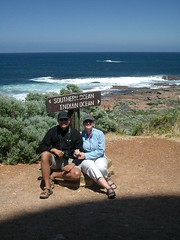 From Bunbury we headed further south. Along the way we stopped in Busselton, which has the longest wooden jetty in the southern hemisphere. At least it had the longest, a section collapsed in a storm last year, so maybe it isn’t the longest anymore. Either way it’s quite impressive at just over 1.8km, which is a fair walk now that the little train that used to carry tourists is out of action! Rather than a seedy amusement arcade at the end they have built an underwater ‘observatory’. A spiral staircase takes you down 8m to the seabed where you can watch the local marine life. All the entry fees go towards the repairs to the jetty (which needs about ($18 million at the moment) so it’s all for a good cause.
From Bunbury we headed further south. Along the way we stopped in Busselton, which has the longest wooden jetty in the southern hemisphere. At least it had the longest, a section collapsed in a storm last year, so maybe it isn’t the longest anymore. Either way it’s quite impressive at just over 1.8km, which is a fair walk now that the little train that used to carry tourists is out of action! Rather than a seedy amusement arcade at the end they have built an underwater ‘observatory’. A spiral staircase takes you down 8m to the seabed where you can watch the local marine life. All the entry fees go towards the repairs to the jetty (which needs about ($18 million at the moment) so it’s all for a good cause.Our stop for the night was the town of Margaret River which also happens to be the centre of yet another wine region, so we finished the afternoon with a couple of tasting visits and ended up with a half case of wine to add to our luggage!
The following day we visited Cape Leeuwin, the point where the Indian and Southern Oceans meet. Of course you can’t see any difference between the two bodies of water, but there’s a nice little sign so you can take your holiday photo! This is also the most South Westerly point in Australia, so we are almost as close to the South Pole as we are to the far North East of Australia (actually there’s probably about 1000km in it, but it sounds good!).
Monday, February 06, 2006
Bunbury
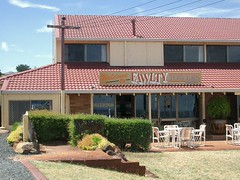 After a couple of days in Fremantle we’re back on the road again and heading south. Along the way we got to see some new housing developments, and it seems that even in Australia people want “Luxury Apartments” and “Waterfront Living”. Unfortunately (or maybe this was what they were after), the developers seem to be building something that looks like the worst of the Spanish east coast, or perhaps Playa de las Americas. Nice. We didn’t get any good photos, but when we reached Bunbury we found more so there are a couple in that set of pictures. If the Spanish style architecture doesn't do it for you then you could always choose to stay at the Fawlty Towers motel.....
After a couple of days in Fremantle we’re back on the road again and heading south. Along the way we got to see some new housing developments, and it seems that even in Australia people want “Luxury Apartments” and “Waterfront Living”. Unfortunately (or maybe this was what they were after), the developers seem to be building something that looks like the worst of the Spanish east coast, or perhaps Playa de las Americas. Nice. We didn’t get any good photos, but when we reached Bunbury we found more so there are a couple in that set of pictures. If the Spanish style architecture doesn't do it for you then you could always choose to stay at the Fawlty Towers motel.....Bunbury seems quite small but is apparently the second largest city in Western Australia, which really just underlines how few people live in a state that is something like 8 times the size of the UK. The main tourist attraction here is the Dolphin Discovery Centre, a few years ago some dolphins were fed here and their descendants have been returning ever since. You can opt for the $100 ‘Swim with dolphins tour’ if you like, but this just seemed too expensive to us so we opted for the $4 ‘Stand on the beach’ option.
You have to get up early for this, as the dolphins can turn up at any time after about 7:30am. So we were there just before 8, up to our knees in fairly cold water. It was well worth it though as the dolphins arrived on cue and stayed for about half an hour. They are only fed about 200g of fish a day (we were told that an adult daily requirement is around 14kg), so they certainly don’t rely on the food supply. It seems like a social event for them, and they appear to actually enjoy swimming up and down for no reason other than to amuse the weird humans who just stand in the sea watching them.
If you have a mask and snorkel you can go out a bit further in a small group and attempt to watch the dolphins underwater. The visibilty wasn’t that great when I tried this, but you can certainly hear them ‘talking’ to each other when you get your head underwater. Many people also bring children with physical or mental disabilities here, and it seems that the dolphins have figured this out too. They certainly seem to make a point of spending more time with the kids (who are slightly to the side of the main group of spectators).
Note for Hitchhikers Guide to the Galaxy fans: It is of course entirely possible that all this larking about in the shallow water is, as Douglas Adams predicted, just an attempt to warn us of an impending visit by aliens. I did have a quick look around the visitor centre but this doesn’t seem to have been considered.
Friday, February 03, 2006
Fremantle
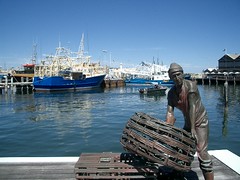 On most maps Perth looks like it’s on the coast, but the city centre is actually a few miles inland. The actual port is down the Swan river at the town of Fremantle, or ‘Freo’ as the locals call it (yet another example of the Australian habit of shortening words to no more than a couple of syllables where possible).
On most maps Perth looks like it’s on the coast, but the city centre is actually a few miles inland. The actual port is down the Swan river at the town of Fremantle, or ‘Freo’ as the locals call it (yet another example of the Australian habit of shortening words to no more than a couple of syllables where possible).We took a one way cruise down the river as a scenic alternative to the bus or train. It’s quite a pleasant trip, and it lets you see where all the money on the west coast lives. If any of you think that everyone here lives in a tin shack (like the ones in the XXXX beer adverts) take a look at the photos.
Top dining tip in Freo (well, the one place we ate out) was the typically Australian.......... Sushi Train! Top drinking tip was actually suggested to us by a friend (thanks PJ!), but we can second the recommendation so make sure you pay a visit to the Small Creatures brewery/bar. Rather than a pub that brews beer downstairs it's actually a brewery with a bar in it. Great idea, but the 'open-fronted warehouse' design style might not work too well in the British seaside climate.
